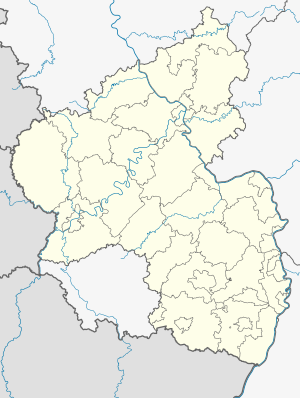Rammelsbach tunnel
|
Rammelsbach tunnel Altenglaner tunnel
|
||
|---|---|---|
| use | Railway tunnel | |
| traffic connection | Landstuhl – Kusel railway line | |
| place | Rammelsbach | |
| length | 143 m | |
| Number of tubes | 1 | |
| construction | ||
| Client | Society of the Palatinate Northern Railways | |
| building-costs | 24,000 fl | |
| start of building | 1866 | |
| completion | August 28, 1868 | |
| business | ||
| release | September 22, 1868 | |
| location | ||
|
|
||
| Coordinates | ||
| East portal | 49 ° 33 ′ 3 ″ N , 7 ° 27 ′ 24 ″ E | |
| West portal | 49 ° 32 ′ 58 " N , 7 ° 27 ′ 12" E | |
The Rammelsbacher Tunnel , also called Altenglaner Tunnel , was a railway tunnel operated from 1868 to 1936 on the Landstuhl – Kusel railway line between the Altenglan and Rammelsbach stations . In the 1930s, the route of the railway line was changed in this area, which then bricked up the tunnel.
history
As early as the 1860s, railway construction committees were formed in both Ramstein and Kusel. In 1863 this resulted in a memorandum that proclaimed the construction of a railway line from Landstuhl on the Palatinate Ludwig Railway along Mohrbach , Glan and Kuselbach to Kusel. While the course from Landstuhl to Altenglan was largely predetermined by the first two rivers mentioned, turning into the Kuselbachtal was more complicated. Therefore, the foothills of the Remigiusberg between Altenglan and Kusel were crossed under by means of a tunnel, the so-called Rammelsbacher tunnel .
In order to save costs, its design was very slim. For the construction of the tunnel, which took place from 1866, a total of 24,000 guilders were estimated. In 1892 there was a fatal accident because a 22 year old man used it as an abbreviation for a footpath. The narrow clearance profile prevented that he could avoid a train driving through the tunnel.
Over the decades, the tunnel became increasingly dilapidated. In addition, the small cross-section was a problem, especially when transporting goods. This sometimes meant that the freight had to be unloaded in Altenglan and transported to Kusel by carts. For this reason, the railway line was led around the mountain from 1936. During the Second World War , the tunnel, which had become superfluous for regular operations, was used to park locomotives; it was also converted into a workshop for repairs. After the Palatinate was occupied by France after the war, its troops used the tunnel as a depot. Later the portals of the tunnel were bricked up.
literature
- Hans-Joachim Emich, Rolf Becker: The railways on Glan and Lauter . Self-published, Waldmohr 1996, ISBN 3-9804919-0-0 .
Individual evidence
- ^ Eisenbahn-tunnel-info.de: German railway tunnels, sorted by tunnel name . Retrieved February 5, 2013 .
- ↑ Hans-Joachim Emich, Rolf Becker: The railways to Glan and Lauter . 1996, p. 7th ff .
- ↑ eisenbahn-tunnelportale.de: Tunnel portals - pictures of the route: 3202 (KBS 671 / KBS 272d) . Retrieved February 5, 2013 .
- ↑ Hans-Joachim Emich, Rolf Becker: The railways to Glan and Lauter . 1996, p. 35 .
- ↑ Hans-Joachim Emich, Rolf Becker: The railways to Glan and Lauter . 1996, p. 12 .
- ↑ Hans-Joachim Emich, Rolf Becker: The railways to Glan and Lauter . 1996, p. 49 .
